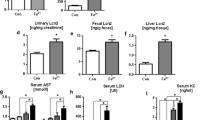Abstract
Acute and chronic inflammatory states are characterized by changes in body iron metabolism. These changes include a drop in serum iron, an increase in the rate of plasma iron disappearance, a decline in the rate of plasma iron turnover, reticuloendothelial system (RES) cell iron sequestration and a decline in intestinal iron absorption. This response is elicited by a variety of metabolic conditions and acute bacterial infections, especially gram-negative bacteria, and by experimental mediators of inflammation such as endotoxin and turpentine. These changes in iron metabolism contribute to the development of the anemia of chronic diseases. SLC11A3 (aka MTP1, ferroportin 1, IREG1) is a metal transporter that exports iron from the cytosol of cells and was initially identified as the duodenal epithelial basolateral iron transporter. Recent identification of a MTP1 mutation leading to hemochromatosis in man adds further weight to the hypothesis that MTP1 is involved in iron homeostasis. RES cells are responsible for the recycling of iron from the breakdown of heme from senescent erythrocytes and MTP1 has been hypothesized to be the key iron exporter in these cells. Supporting this hypothesis is the observation that MTP1 is expressed in the RES macrophages of the spleen, Kupffer cells, bone marrow and lymph node histiocytes, mesangial cells, brain microglial cells. In a mouse (C57/Bl6) model of lipopolysaccharide (LPS) induced acute inflammation, MTP1 expression in the cells of the RES is regulated by acute inflammation. Immunohistochemical staining of tissues, using an anti-MTP1 antibody, of mice given parenteral injections of LPS demonstrated down-regulation of MTP1 expression in the RES cells of the spleen and liver and also in the duodenal epithelial cells compared to control animals. Western blotting of total liver and spleen lysates confirmed the decline in MTP1 protein expression induced by LPS. In addition, RT-PCR analysis showed that LPS treatment also resulted in a decline in MTP1 mRNA in spleen, liver and duodenum compared to controls. One clue to the molecular signaling mechanism for MTP1 down-regulation by LPS comes from the study of the C3H/HeJ mouse, which lacks a functional LPS receptor, toll-like receptor 4 (TLR4). C3H/HeJ mice are resistant to the toxic and hypoferraemic effects of LPS. Similarly, a down-regulation of MTP1 in response to LPS in the C3H/HeJ mice was not observed. This finding indicates that the down-regulation of MTP1 by LPS requires signaling through TLR4. Despite resistance to LPS, treatment of C3H/HeJ mice with turpentine, an inducer of sterile inflammation, for a period of 24 hours resulted in down-regulation of MTP1 expression in the spleen. These data indicate that LPS mediated down-regulation of MTP1 requires a functional TLR4, but that there are non-TLR4 dependent mechanisms for the down-regulation of MTP1 by inflammatory stimuli. In vitro treatment of mouse adherent splenocytes with 5 ug ml of LPS also resulted in down-regulation of MTP1 mRNA. This in vitro down-regulation was not abrogated by co-treatment of cells with pyrrolidinedithiocarbamate (PDTC), a well-characterized inhibitor of NF-KB activation or anti-tumor necrosis factor-a antibodies. In addition, in vitro treatment of mouse splenocytes with recombinant TNF-α did not result in down-regulation of MTP1 mRNA. The lack of antagonism between LPS and PDTC and the lack of an effect of TNF-α in vitro indicates that NF-κB activation may not be required for MTP1 mRNA down-regulation. This inflammation-mediated down-regulation of MTP1 expression in the RES may be a component responsible for iron sequestration in the RES in both acute and chronic inflammatory states.
Similar content being viewed by others
References
Stephenson GF, Chan HM, Cherian MG. 1994 Toxicol Appl Pharmacol 125, 90-96.
Suzuki Y, Apostolova MD, Cherian MG. 2000 Toxicology 145, 51-60.
Cherian MG, Suzuki Y, Apostolova MD. 2000 Meth Enzymol 348 (in press).
Author information
Authors and Affiliations
Rights and permissions
About this article
Cite this article
Haile, D.H. Regulation of SLC11A3 by inflammation. Biometals 16, 225–241 (2003). https://doi.org/10.1023/A:1020779219401
Issue Date:
DOI: https://doi.org/10.1023/A:1020779219401




